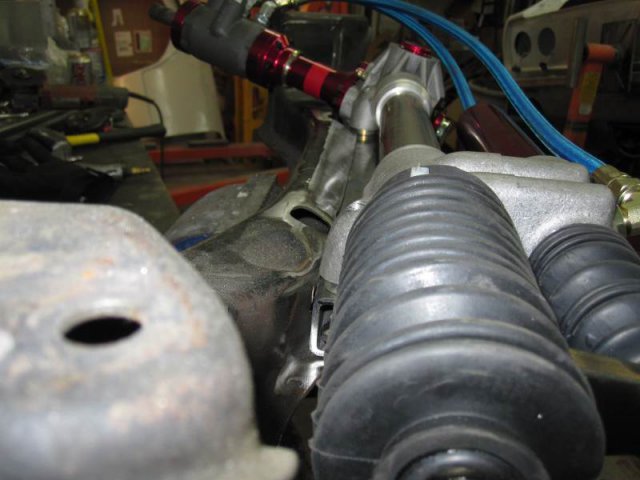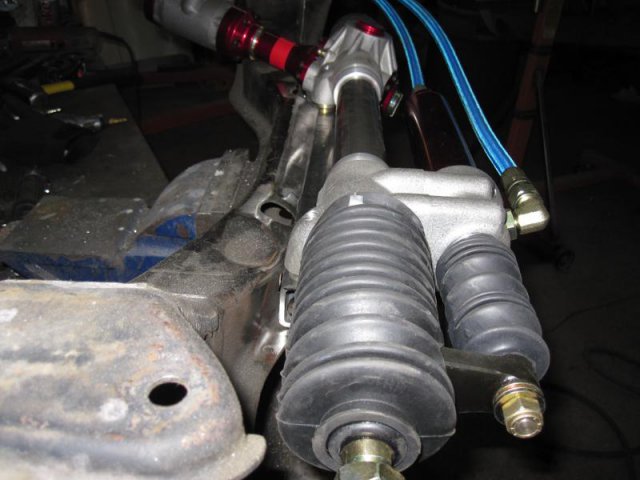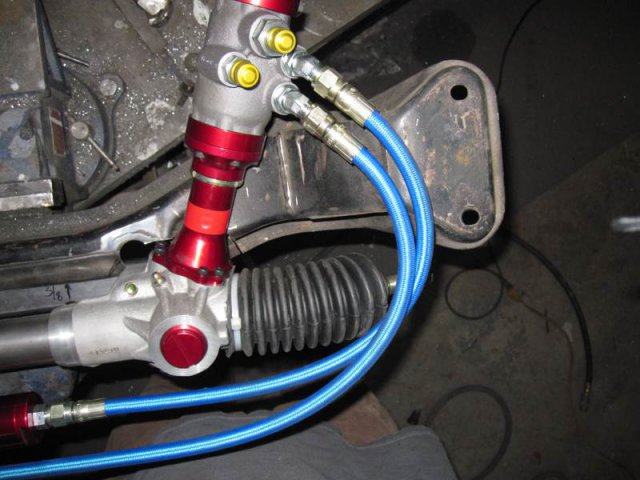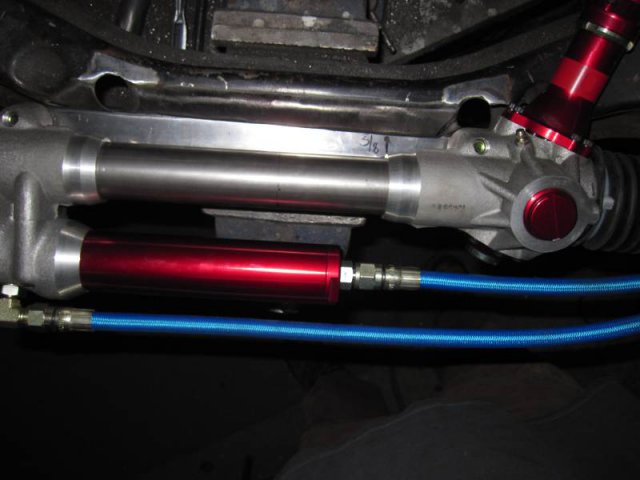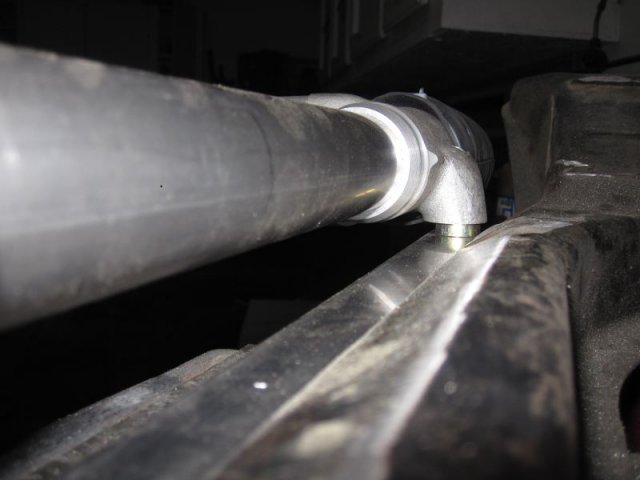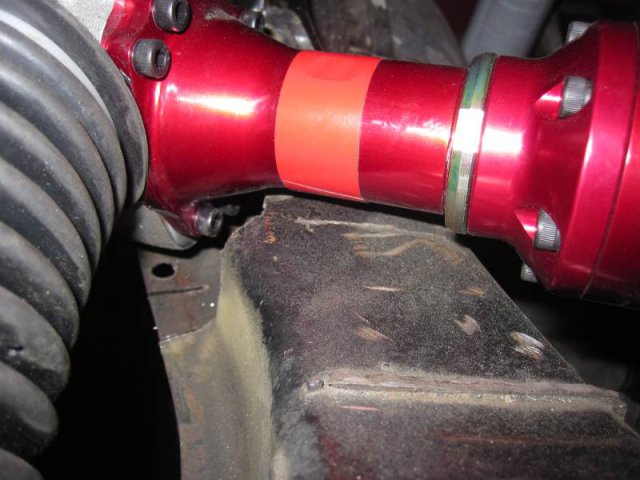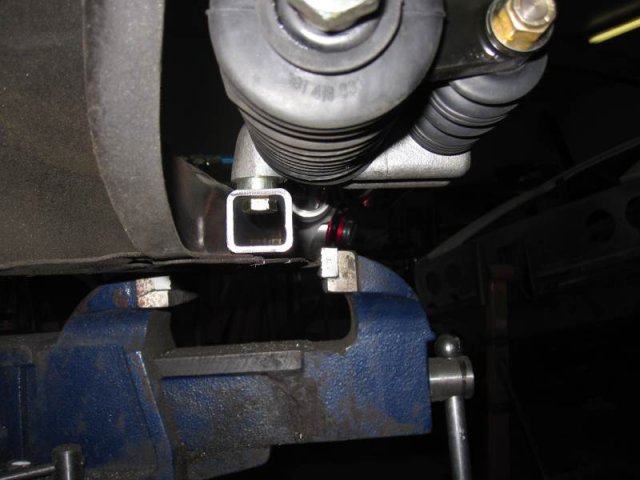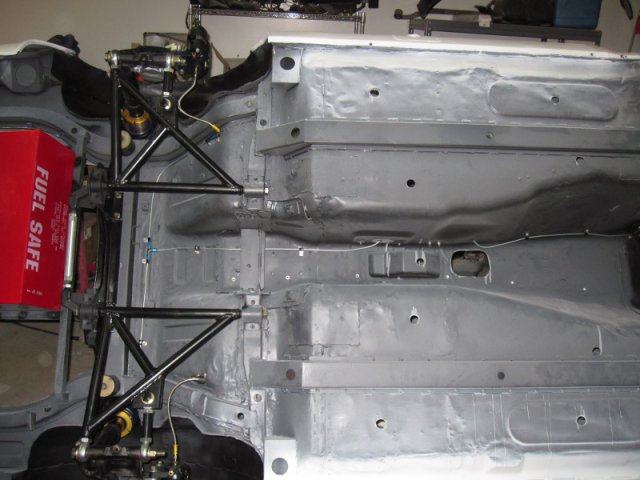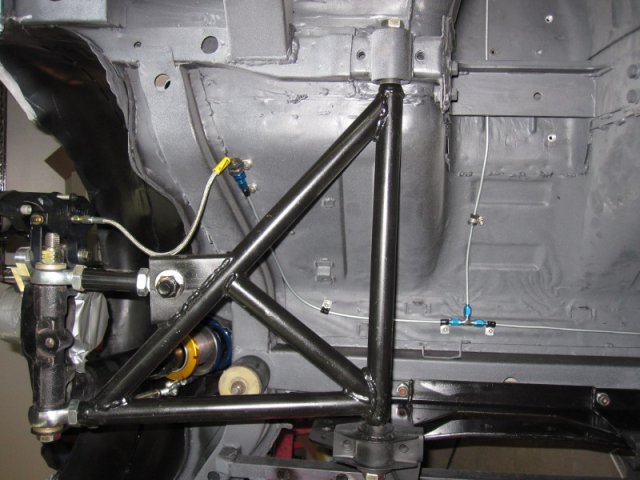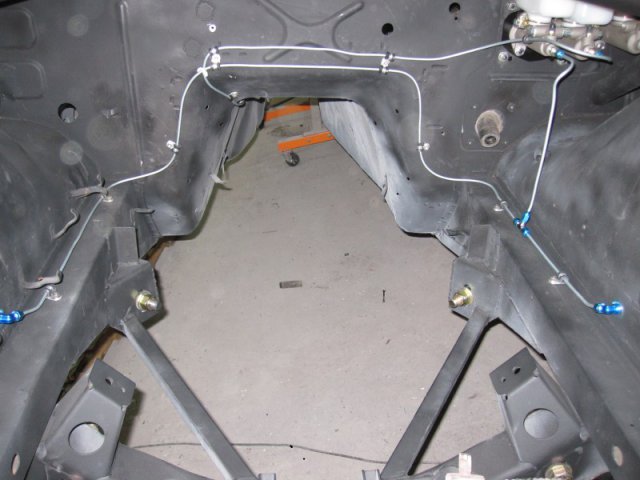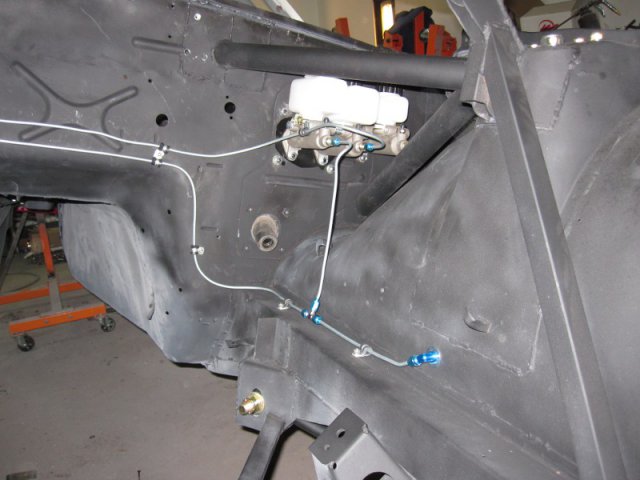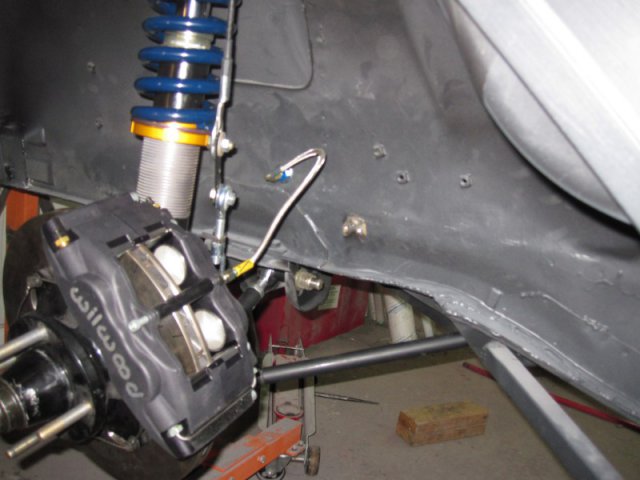-
Posts
13742 -
Joined
-
Last visited
-
Days Won
67
Content Type
Profiles
Forums
Blogs
Events
Gallery
Downloads
Store
Everything posted by JMortensen
-
Woodward power steering project
JMortensen replied to JMortensen's topic in Brakes, Wheels, Suspension and Chassis
This rack is taller due to the larger diameter tube in the middle, and I think my previous mod made it higher than stock. Sounds like I'm into the firewall... -
Woodward power steering project
JMortensen replied to JMortensen's topic in Brakes, Wheels, Suspension and Chassis
Do you have the diameter of your pulley handy? If I had to guess, I'd say I cut it about in half. I could move it forward an inch and that should be just about at the front of the C part. Part of the idea here was to get the rack more closely tied into the crossmember. If I move it way out, then it would need a lot of gusseting to be as strong as it would be if I welded in where it is now. I could do something in between though, it doesn't have to be one extreme or the other. -
Woodward power steering project
JMortensen replied to JMortensen's topic in Brakes, Wheels, Suspension and Chassis
The C channel raised part of the crossmember has been cut and the plan is to weld the tube to it and the bottom of the crossmember. Sounds like it's going to be too far back though. I could start over with the other crossmember and move the rack forward again. A 1" change in the rack position forward really won't change steering angles much at all and would actually be 1/8" forward from stock. The problem is that the center tube on this rack is a lot thicker than the Datsun part, so I'll probably be RIGHT UP against the firewall if I do that. I guess the other option is cutting the firewall to clear the head. If you cut (or hammered) yours just enough to move the engine back 1" from where it currently sits, would you have to modify both sides, or just one? Can I get a pic of the firewall where the interference would likely be? Thanks. -
Woodward power steering project
JMortensen replied to JMortensen's topic in Brakes, Wheels, Suspension and Chassis
I made some progress and actually got the rack into the position the old rack was in after I moved it back, but now I'm at a point where I am a little worried about the position of the rack vs the crank pulley. I'm not using John's Cars mounts, but my main concern is whether I will be able to move the motor far enough back for the crank pulley to clear. I was planning on setting the motor back as far as possible, but I'm not sure how much room I have to work with. The top of the rack is exactly 1.5" taller than the crossmember with it sitting on 1/4" bumpsteer spacers. It will actually be 1/8" lower than that, so figure a total height from the crossmember to the top of the rack of 1 3/8". The stock crossmember has a raised section that is 2" wide from front to back. The rear part of my rack is 2 1/8" from the back of the raised portion of the rack. In retrospect, the engine mount towers really did need to come off, so that wasn't wasted motion... -
Woodward power steering project
JMortensen replied to JMortensen's topic in Brakes, Wheels, Suspension and Chassis
Cary came up with a very good idea for rack mounting, which is basically 1.5" square tube with a 7/16" hole drilled in the top and a large hole in the bottom so the bolts can be inserted and a socket used to tighten them up. I checked it out on the crossmember and it looked like it was going to work pretty well, and the fab work actually looked pretty easy. Basically just cut the top of the crossmember so that the tubing rests on the bottom skid plate, and then weld it in across the top (presumably with a gusset. To follow Tony's recommendation, I'll double up the mount points so that they are 1/4" thick. I've been slammed with the differential business, which is now really up and running (still nothing for Z cars aside from a couple seals, oil and LSD additive). I did have to order 1.5" square tubing and I got it in a couple days ago, but just haven't been able to make it out to the shop. I think with the way I'm planning on tying in the tube to the crossmember it will be OK, but I guess I'll have to put it together to test it out and see how it holds up. I'm finally getting back to normal on the work side of things, so I'm going to try and get out to the shop maybe tomorrow. I don't think the mount will be that hard to fab up, so I might be able to get it at least on the crossmember in the next couple days. I did figure out that the rack mounting holes are not centered, so I probably didn't need to cut the engine mount towers off. Oops. I think I'll have to take a look and see whether I want to run the stock towers or make my own mounts from the motor to the frame rails, and that will determine whether I leave the crossmember that is in the car in it, or if I switch them out, which will be slightly more of a pain in the ass seeing as how I welded the crossmember in. When I get it running and have run a few local races under me just to make sure that I'm comfortable that I've worked out the bugs, then I'm going to run every autox I can, so I'll probably be headed out your way, wheelman. I think it's going to be next season. I was doing really good over the winter, but this spring I haven't really done anything at all due to the new business coming together. Unless something changes, I think it's going to be on and off like this for a while. -
I used to work on a Porsche that had a wing like that, and they do work. If putting something that works on your car makes you a ricer, then call me a ricer. Not much for the zip ties and all that, but the wing is functional, and that makes it worth having.
-
The 3.54 came in the automatic. 240Z with manual transmission came with 3.36.
-
8" springs are too short for lower spring rates. I'd stick to 10's unless the spring rate is over about 350. That's a SWAG. To really figure it out correctly, someone could look at Eibach's website and see how much travel they could get before coil binding, and make sure that at the height they wanted the 8" wouldn't coil bind. I have no idea what you're talking about when you say preload. Preload means that the spring perch is turned up so that it the spring is partially compressed even when the car is up on jackstands. It is possible to do this with coilovers, but your car will be higher than stock set up like this. I think you might mean sag, which is the measurement of how far the suspension compresses with the weight of the car on it. This is a simple math problem. Say one corner of the car weighs 600 lbs. You install a 300 in/lb spring. The amount of sag will be 600 / 300 = 2 inches. With 175 in/lb springs the sag will on a Z will be close to 3". Stock front spring rate is something like 83 lbs if I recall, rear is 105. That's memory, so check if you really need the hard numbers. I drove around with my 75 year old dad on 200/250 springs with Illuminas set on 1. His comment about the car was how comfortable the Recaro seat was.
-
It's not a problem. Sometimes my posts are in dire need of some contradiction. Just not this time...
-
Bolt in Limited Slip conversion - Looking for MFR name
JMortensen replied to xonix_digital's topic in Non Tech Board
Phantom Grip. You're right. Not ideal. -
I will do that! Thanks for the lead. NewZed, the 74 260 2+2 had an R200 with 3.36's. Search it, you'll see that I'm right, regardless of what the FSM says.
-
79ZX 2+2, 74 260 2+2, that's about it. You can buy aftermarket gears from OS Giken and I think they have a 3.15, but the gears are very expensive. If you're looking for other suggestions, I'd really like to see someone do a Ford 8.8 IRS diff, and you can get 3.08 and 3.27 gears from my business www.m2differentials.com, among others. I don't know anyone who has done the F8.8 swap, but there are lots of limited slips and locker options and gear options, just need to figure out how to mount the sucker and get the CV's adapted. Probably easiest to use a custom splined shaft made that fits the Ford inner and a Z31T or S130T outer and use MM's adapters.
-
I'm still thinking the oil rings just aren't seated. I'd reassemble and then drive the piss out of it (redline it, let off gas, redline it again, etc) for a day or two and see if the smoke goes away.
-
Tokico lowering springs (problem with rears) Question
JMortensen replied to SportZ2's topic in S30 Series - 240z, 260z, 280z
Longer springs in rear is the key. Loose is normal with lowering springs. They are intended to be loose. Do a search here or at www.classiczcars.com and you'll see countless threads from people installing the springs wondering if the springs are going to fall out just like you are. Zip tie them up if it makes you feel better, but it is very unlikely that you would be driving around and the spring would come loose, unless like I said, you were catching some big air and the suspension was drooping all the way down to where the spring was loose. My guess on the noise is that based on the strut going bad the insert is loose in the housing. When you tighten the gland nut there should be a couple threads showing. If the nut bottoms out on the housing and the strut is still loose, it will make all kinds of noise when you go over bumps. It also beats up the strut, hence the seal going bad. Search "gland nut" here and on classiczcars.com and you'll see that this noise also happens pretty frequently. It happened to me with a set of Illuminas on my 240. I had to put a big washer in the bottom of each strut housing in order to fix it. -
rear suspension to chassis mounts.......
JMortensen replied to ZROSSA's topic in Brakes, Wheels, Suspension and Chassis
Racers have cracked the uprights in back. That's empirical enough for me. I like the diag braces, but I'm not sure I like them going to the mustache bar, since there is a poly bushing there. I'd shoot for a brace to a frame rail instead. -
In general if the weld is tall, you're too cold. Turn the power up. In this case though, at least part of the problem is that the weld isn't going into a joint. If you cut the metal and beveled the edges, then welded them back together, the weld would sink down into the joint. Welding on top of a piece of metal is not terribly useful practice. Cut some up and weld it back together and you'll learn a lot more about having tight gaps, beveling, turning the power up too high and burning through, etc. Keep at it!
-
There really isn't much you can do about it unless you have adjustable control arms. Solutions pretty well boil down to lengthening the control arm or getting a custom shorter CV shaft. If you want to check for bind, take the driver's side spring off, disconnect the sway bar, then move the suspension all the way up and down by hand (not with a jack) and see if you can feel the CV bottoming out.
-
The problem is you not only need the custom shaft, you need the companion flange adapter as well, and I don't think there is one. I haven't looked at the 300ZX NA shafts in a very long time, but I think they're 6 equally spaced holes, not three pairs like the 280ZX shafts. Maybe one of the R230 adapters works, I don't know. I don't think the 300ZX shafts are going to be a weak point that causes problems for the vast majority of us though. Maybe for the guy who is trying to turn 9 second 1/4 mile times...
-
Tokico lowering springs (problem with rears) Question
JMortensen replied to SportZ2's topic in S30 Series - 240z, 260z, 280z
The springs won't be LOOSE unless you completely droop the suspension, we're talking Dukes of Hazzard style jumps here. Just going over bumps or dips in the road, not going to happen. You might check and make sure that the springs are in the perches correctly. -
questions on how to plumb brake lines
JMortensen replied to yem73z's topic in Brakes, Wheels, Suspension and Chassis
Yeah, but that's talking about the pistons moving out as the pads wear. I always assumed that there was a limit to the elasticity of the piston seals, and after that was reached the piston then pushed through the seal and closer to the rotor. In this case the piston is sliding through the seal due to prolonged pressure on the pedal. I'm not taking issue with you or saying you're wrong, it's just different than what the Lexus manual shows, and not the usual scenario. For comparison, if you have 280ZX rear calipers and you pull the ebrake, the pistons still move in the seals to push on the pads, but they don't commonly slide past the seals and require retraction. Maybe there is a return spring in there and that's why they require the screw adjuster, I don't know. -
questions on how to plumb brake lines
JMortensen replied to yem73z's topic in Brakes, Wheels, Suspension and Chassis
Weird. That's a new one to me. Interesting though. -
I wouldn't try to use Bilsteins off of a different car compare with the Z struts. I would think that the stock valving would do great with 200 in/lb springs. The revalve that everyone is getting isn't changing things a whole lot. Specs are in that thread, but I seem to remember the stock valving was something like 72/256, and the revalve is 100/300.
-
questions on how to plumb brake lines
JMortensen replied to yem73z's topic in Brakes, Wheels, Suspension and Chassis
A guess at the cause might be that he puts the brakes on at night, then the fluid expands when the sun comes up, so now he has the brakes on REALLY hard, and it's hard to release. If possible, might suggest he tries putting them on very lightly. That's a SWAG. For the OP, I think my plumbing came out pretty friggin awesome. I had removed all the fuel lines and brake lines and cut the fittings off of the chassis, so I really was starting from scratch. I was looking at the stock fittings and the brake lines curving under the frame rails, etc, and didn't like it, instead I used bulkhead fittings through the fenders. I did delete the prop valve in the car, so now the line that goes to the rear brakes just goes straight down the trans tunnel. Your's would obviously be a little different because you don't have dual masters, but I think the actual brake setup is pretty similar. I used AN fittings throughout, I think that's a good idea because AN fittings are easier to deal with than double flares. I've done lots of double flares before, so I can say this having experience with both. I used cheapo brake line from Summit and bent it mostly by hand even though I do have a couple of benders. I had to buy another coil of line to remove the prop valve, and I bought that at the local NAPA. The stuff from NAPA was much harder to flare without splitting. I think if I were going to do it again, I'd do cupronickel hard lines. It's supposed to be the easiest to work with. FWIW your sketch looks fine in terms of placement of the prop valve and the line lock, etc. -
Race Car Rear wing and Aero???? 240 IMSA GTU Car
JMortensen replied to cobramatt's topic in Body Kits & Paint
I'm sure the hood is very thin, but put it in perspective too. Let's say you can generate .1 psi pressure differential on the hood, and the hood is 36 x 48 inches (not actual dimensions, BTW). That would give you 172.8 lbs of force on the hood, from only .1 psi of pressure differential. -
Race Car Rear wing and Aero???? 240 IMSA GTU Car
JMortensen replied to cobramatt's topic in Body Kits & Paint
I would err on the side of too much aero derived rear traction rather than too little. Oversteer at high speeds is not desireable, regardless of your hp.

